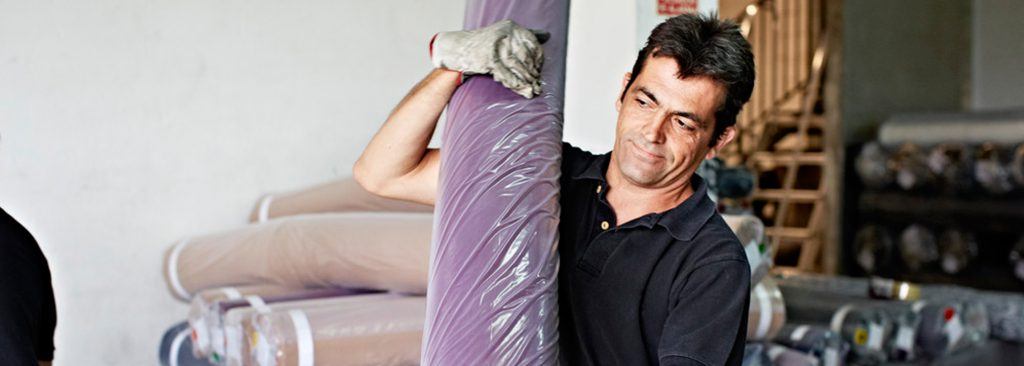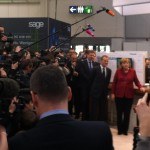Digitale Transformation
[English] When ISDN was a dream: On CeBIT, from Poland

[Guest blog post from Piotr Durski] I visited CeBIT twice. First time well back in my university times, when I was studying Journalism. In the early nineties, just a few years after the fall of the Berlin Wall. With a bunch of ot her students, on a summer workshops, invited by some NGO, for a week we toured around some TV and radio stations in few German cities, learning secrets of an underground bunker of dpa and joined press conference of a government representative in Bonn (after a fabulous long walk on a border of Rhenium). The bus travel from Warsaw to the border of Germany lasted almost a whole day.
For the first time I saw computers in editorials and remote cameras in TV studios. At that time, typing machines were still widely used by journalists in Warsaw and faxes were quickly gaining popularity. In Hannover we were welcomed by a woman from the Messe AG Press Office, who took us on quick tour on the fair grounds. It was her charm and natural hospitality that probably caused me to decide some time later that I want to work in PR, which of course I am now.
Then again, almost 13 years ago, as a columnist and a market reporter for a computer weekly, I have been strolling through massive halls, between booths and stands flooded with too many PC accessories, graphic cards and hard disks. The amount of latest equipment there was unbelievable, almost overkill. Who dares to remember ZIP drives, Voodoo accelerators and VFX helmets today? The Net was booming at that time, but an ISDN line was a dream for many users, especially in Poland, where we were still using 56K modems. Do you remember that cell phones had black and white displays, with just a few lines of text? Forget it…
with too many PC accessories, graphic cards and hard disks. The amount of latest equipment there was unbelievable, almost overkill. Who dares to remember ZIP drives, Voodoo accelerators and VFX helmets today? The Net was booming at that time, but an ISDN line was a dream for many users, especially in Poland, where we were still using 56K modems. Do you remember that cell phones had black and white displays, with just a few lines of text? Forget it…
Today, CeBIT 2013 has selected „Shareconomy“ as keynote theme and the country of Poland as an Official Partner. As one of the most important global event for the digital world, CeBIT will spotlight this sweeping trend that emphasizes sharing knowledge, resources and experience to create new forms of collaboration. Do you want an example of such collaboration from Poland? Here it is: The worlds fastest microprocessor from the so called „8051 family“ will be shown at the opening ceremony of this year’s CeBIT in Hanover. This tiny chip designed and built in Poland,  will be one of four devices presented to Chancellor Merkel and Prime Minister Tusk, who shall open this years fair. An advanced piece of silicone from city of Bytom (where, by coincidence, Sage has one of it’s branch offices also), will represent Polish achievements in the IT industry. This hot little device, developed by Polish company called Digital Core Design, is over 66 times faster then it is competitors. It was already licensed to IT moguls like Intel, Sony, Philips and Siemens. Is it „Shareconomy„…? I believe so. By the way: you can have this type of microchip integrated on a SIM card in your iPhone or Blackberry, while almost half of worlds USB devices, including pendrives, include such chips. However, this not the only reason I envy my friends from Sage Germany: they will have a chance to visit Polish stand during this years CeBIT. I hope it will be as interesting and well-designed as last year, when the stand of Polish Ministry of Economy won Silver Medal from Industry of Fairs Chamber. This will be also a good address for entrepreneurs from both Poland and Germany. Why? On 6th and 7th March, from 9.00 am to 12.00 pm, exactly at the stand of the Ministry of Economy, a German law firm will answer queries related to economic activity between Poland and Germany, free of charge – that is „Shareconomy“ for sure!
will be one of four devices presented to Chancellor Merkel and Prime Minister Tusk, who shall open this years fair. An advanced piece of silicone from city of Bytom (where, by coincidence, Sage has one of it’s branch offices also), will represent Polish achievements in the IT industry. This hot little device, developed by Polish company called Digital Core Design, is over 66 times faster then it is competitors. It was already licensed to IT moguls like Intel, Sony, Philips and Siemens. Is it „Shareconomy„…? I believe so. By the way: you can have this type of microchip integrated on a SIM card in your iPhone or Blackberry, while almost half of worlds USB devices, including pendrives, include such chips. However, this not the only reason I envy my friends from Sage Germany: they will have a chance to visit Polish stand during this years CeBIT. I hope it will be as interesting and well-designed as last year, when the stand of Polish Ministry of Economy won Silver Medal from Industry of Fairs Chamber. This will be also a good address for entrepreneurs from both Poland and Germany. Why? On 6th and 7th March, from 9.00 am to 12.00 pm, exactly at the stand of the Ministry of Economy, a German law firm will answer queries related to economic activity between Poland and Germany, free of charge – that is „Shareconomy“ for sure!
by Piotr Durski, Poland
Piotr Durski is a PR Manager of Sage in Poland. He joined company in 2006, almost a year after Sage Group entered Polish market. At that time, the Polish company was called Sage Symfonia and offered three software product lines (mostly for accounting and payroll) to 36 000 business customers. Today, Sage has over 66 000 customers in Poland, from entry level to mid-market. It is product range includes software and services for most business areas, like finance, trade, manufacturing and HR. Recent additions to company portfolio in Poland are Sage ERP X3 – for mid-market customers with international ambitions and multi-national requirements and an unique connected service for exchanging of electronic documents – miedzyfirmami.pl.







